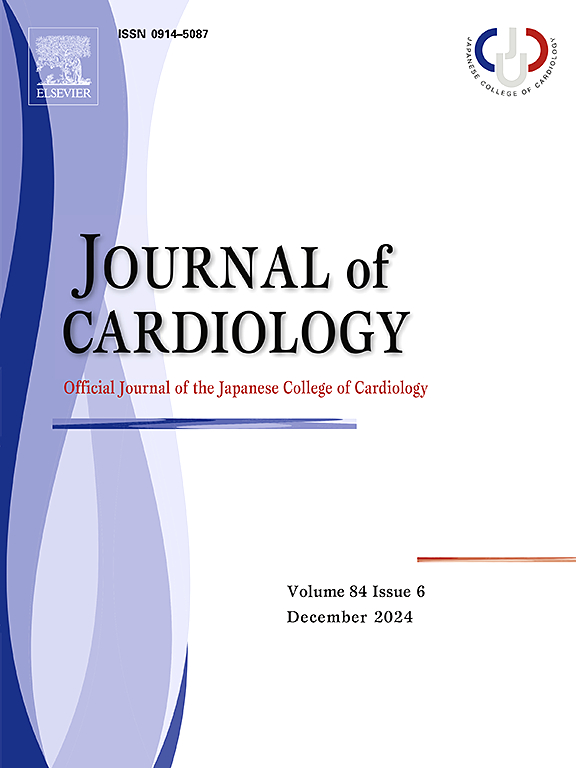Comparison of clinical outcomes between proximal and non-proximal right coronary artery occlusion in patients with inferior ST-segment elevation myocardial infarction
IF 2.5
3区 医学
Q2 CARDIAC & CARDIOVASCULAR SYSTEMS
引用次数: 0
Abstract
Background
The clinical outcomes of ST-segment elevation myocardial infarction (STEMI) due to the occlusion of left coronary artery are worse in patients with proximal occlusion than in those with non-proximal occlusion. However, there are few reports that focus on the comparison of clinical outcomes in patients with STEMI between proximal and non-proximal right coronary artery (RCA) occlusions.
Methods
We included 356 patients with STEMI whose infarct-related artery is RCA and divided them into the proximal group (n = 129) and the non-proximal group (n = 227). We defined segment 1 of RCA as proximal, and segments 2, 3, and 4 as non-proximal according to the reporting system of the American Heart Association. The primary endpoint was major cardiovascular events (MACE), which was defined as the composite of all-cause death, non-fatal myocardial infarction, readmission for heart failure, and ischemia-driven target vessel revascularization.
Results
Incidence of shock at admission, requirement for catecholamine during percutaneous coronary intervention (PCI), or mechanical support during PCI tended to be higher in the proximal group (42.6 %) than in the non-proximal group (33.5 %) (p = 0.088). Although the incidence of right ventricular infarction tended to be higher in the proximal group (17.8 %) than in the non-proximal group (10.6 %) without reaching statistical significance (p = 0.072), the incidence of in-hospital death was similar between the 2 groups (1.6 % versus 1.8 %, p = 1.000). The MACE-free survival curves were not different between the 2 groups (p = 0.400). Multivariate Cox hazard analysis revealed that proximal RCA occlusion was not associated with MACE (HR 1.095, 95%CI 0.691–1.737, p = 0.699).
Conclusions
Although the acute phase conditions such as shock or right ventricular infarction tended to be more severe in patients with proximal occlusion, overall clinical outcomes including long-term outcomes were comparable between the proximal and distal RCA occlusions. Furthermore, multivariate analysis showed that the proximal RCA occlusion was not associated with MACE after hospital discharge.

下ST段抬高型心肌梗死患者近端右冠状动脉闭塞与非近端右冠状动脉闭塞的临床疗效比较。
背景:左冠状动脉近端闭塞的 ST 段抬高型心肌梗死(STEMI)患者的临床预后比非近端闭塞的患者差。然而,很少有报告关注 STEMI 患者近端和非近端右冠状动脉(RCA)闭塞的临床预后比较:我们纳入了 356 名梗死相关动脉为 RCA 的 STEMI 患者,并将其分为近端组(129 人)和非近端组(227 人)。根据美国心脏协会的报告系统,我们将 RCA 第 1 段定义为近端,第 2、3 和 4 段定义为非近端。主要终点是主要心血管事件(MACE),其定义为全因死亡、非致死性心肌梗死、心衰再入院和缺血驱动的靶血管再通术的综合结果:入院时休克、经皮冠状动脉介入治疗(PCI)期间需要儿茶酚胺或PCI期间需要机械支持的发生率,近端组(42.6%)往往高于非近端组(33.5%)(P = 0.088)。虽然近端组(17.8%)的右心室梗死发生率往往高于非近端组(10.6%),但未达到统计学意义(p = 0.072),两组的院内死亡发生率相似(1.6% 对 1.8%,p = 1.000)。两组的无MACE生存曲线无差异(p = 0.400)。多变量 Cox 危险分析显示,近端 RCA 闭塞与 MACE 无关(HR 1.095,95%CI 0.691-1.737,p = 0.699):尽管近端闭塞患者的休克或右心室梗死等急性期症状往往更严重,但RCA近端闭塞和远端闭塞患者的总体临床结果(包括长期结果)相当。此外,多变量分析表明,RCA近端闭塞与出院后的MACE无关。
本文章由计算机程序翻译,如有差异,请以英文原文为准。
求助全文
约1分钟内获得全文
求助全文
来源期刊

Journal of cardiology
CARDIAC & CARDIOVASCULAR SYSTEMS-
CiteScore
4.90
自引率
8.00%
发文量
202
审稿时长
29 days
期刊介绍:
The official journal of the Japanese College of Cardiology is an international, English language, peer-reviewed journal publishing the latest findings in cardiovascular medicine. Journal of Cardiology (JC) aims to publish the highest-quality material covering original basic and clinical research on all aspects of cardiovascular disease. Topics covered include ischemic heart disease, cardiomyopathy, valvular heart disease, vascular disease, hypertension, arrhythmia, congenital heart disease, pharmacological and non-pharmacological treatment, new diagnostic techniques, and cardiovascular imaging. JC also publishes a selection of review articles, clinical trials, short communications, and important messages and letters to the editor.
 求助内容:
求助内容: 应助结果提醒方式:
应助结果提醒方式:


